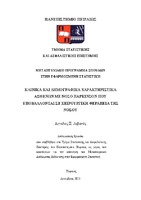Κλινικά και δημογραφικά χαρακτηριστικά ασθενών με νόσο Πάρκινσον που υποβάλλονται σε χειρουργική θεραπεία της νόσου

View/
Subject
Ιατρική στατιστική ; Ιατρική περίθαλψη ; Νόσος του ΠάρκινσονAbstract
Deep brain stimulation (DBS) is a surgical procedure for treating Parkinson’s disease. It is used on patients with serious movement disorder in the “Off’ motor phase and at the same time non-serious disorder in the “On” phase. It is generally considered preferable from lesional surgery because it does not induce permanent brain damage, reduces the levodopa equivalent intake after the surgery and the good effects of the method last longer. The procedure is a relatively new surgical method, approved by FDA (Food and Drug Administration) in 2002 and its application in Greece started taking place very recently. The purpose of this thesis is the statistical examination of clinical and demographic measurements of 22 patients with Parkinson’s disease who received surgical treatment of deep brain stimulation (DBS) at Evangelismos hospital. Half of the patients (11) had good response to the treatment while the rest 11 patients had poor response. We begin with an introduction where we describe our data. Then, some properties of Parkinson’s disease are discussed along with its surgical treatment. After that we proceed by presenting some descriptive statistics along with some principal hypothesis testing. Next, we use multivariate analysis methods such as cluster analysis and discriminant analysis, in order to see which variables can be used to discriminate the patients according to their response (good or poor). We continue by investigating the order of best trajectory utilizing the Bradley-Terry method. Finally, we employ linear regression for modeling the UPDRS scale after the surgery and logistic regression to investigate which variables mostly affect the probability that the patient belongs to the poor response group.


